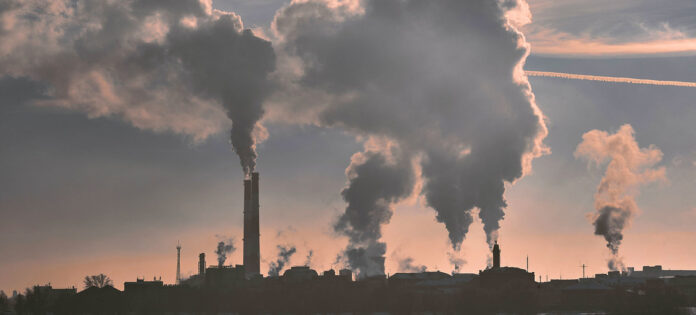The U.N. panel on climate change sounded a dire warning on Monday, saying the world is dangerously close to runaway warming – and that humans are “unequivocally” to blame.
Already, greenhouse gas levels in the atmosphere are high enough to guarantee climate disruption for decades if not centuries, scientists warn in a report from the Intergovernmental Panel on Climate Change (IPCC).
That’s on top of the deadly heat waves, gargantuan hurricanes and other weather extremes that are happening now, and are likely to become more severe.
Describing the report as a “code red for humanity”, U.N. Secretary-General António Guterres urged an end to the use of coal and other highly polluting fossil fuels.
The report describes possible futures depending on how dramatically the world cuts emissions.
But even the severest of cuts are unlikely to prevent global warming of 1.5 degrees Celsius above preindustrial temperatures. Without immediate steep emissions cuts, though, average temperatures could cruise past 2C by the end of the century.
The scientists also looked at events considered less likely but still possible, and they could not rule out big impacts from so-called tipping points, such as the loss of Arctic ice loss or the dieback of forests.
Dr Stephen Cornelius, Chief Adviser on Climate Change and WWF lead on the IPCC, said:
“This is a stark assessment of the frightening future that awaits us if we fail to act. With the world on the brink of irreversible harm, every fraction of a degree of warming matters to limit the dangers of climate change. It is clear that keeping global warming to 1.5°C is hugely challenging and can only be done if urgent action is taken globally to reduce greenhouse gas emissions and protect and restore nature.
“The UK government, as host of the most important climate conference since the Paris Agreement in 2015, must step up its efforts and show climate leadership. This must start at home, with a credible strategy to deliver the promised net zero emissions and a fiscal test to ensure all government spending is compatible with climate targets. We won’t forget the promises that have been made, nor will future generations.”
Weather extremes once considered rare or unprecedented are becoming more common — a trend that will continue even if the world limits global warming to 1.5C
Severe heat waves that happened only once every 50 years are now happening roughly once a decade. Tropical cyclones are getting stronger. Most land areas are seeing more rain or snow fall in a year. Severe droughts are happening 1.7 times as often. And fire seasons are getting longer and more intense.
Scientific advances in the last decade are also helping scientists detect whether climate change caused or worsened specific weather events.
“In the past, people would say ‘you can’t say anything about any individual event,'” said IPCC co-author Michael Wehner, a climate scientist at the Lawrence Berkeley National Laboratory in California. “But now we can actually make quantitative statements about extreme weather events.”
The report, prepared by 234 scientists from 66 countries, highlights that human influence has warmed the climate at a rate that is unprecedented in at least the last 2,000 years.
In 2019, atmospheric CO2 concentrations were higher than at any time in at least 2 million years, and concentrations of methane and nitrous oxide were higher than at any time in the last 800,000 years.
Global surface temperature has increased faster since 1970 than in any other 50-year period over a least the last 2,000 years. For example, temperatures during the most recent decade (2011–2020) exceed those of the most recent multi-century warm period, around 6,500 years ago, the report indicates.
Meanwhile, global mean sea level has risen faster since 1900, than over any preceding century in at least the last 3,000 years.
The document shows that emissions of greenhouse gases from human activities are responsible for approximately 1.1°C of warming between 1850-1900, and finds that averaged over the next 20 years, global temperature is expected to reach or exceed 1.5°C of heating.
Summertime sea ice atop the Arctic Ocean will vanish entirely at least once by 2050, under the IPCC’s most optimistic scenario. The region is the fastest-warming area of the globe – warming at least twice as fast as the global average.
While Arctic sea ice levels vary throughout the year, the average lows during summer have been decreasing since the 1970s and are now at their lowest levels in a thousand years. This melting creates a feedback loop, with reflective ice giving way to darker water that absorbs solar radiation, causing even more warming.
Sea levels are sure to keep rising for hundreds or thousands of years. Even if global warming were halted at 1.5C, the average sea level would still rise about 2 to 3 meters (6 to 10 feet), and maybe more.
Scientists could not rule out extreme rises of more than 15 meters by 2300, if tipping points trigger runaway warming.
“The more we push the climate system … the greater the odds we cross thresholds that we can only poorly project,” said IPCC co-author Bob Kopp, a climate scientist at Rutgers University.
Meeting the Paris Agreement goal of limiting warming to 1.5C will require sticking to a “carbon budget,” a term describing how much additional carbon can be pumped into the atmosphere before that goal is likely out of reach.
With 2.4 trillion tons of climate-warming CO2 added to the atmosphere since the mid-1800s, the average global temperature has risen by 1.1C. That leaves 400 billion tons more that can be added before the carbon budget is blown. Global emissions currently total a little more than 40 billion tons a year.







